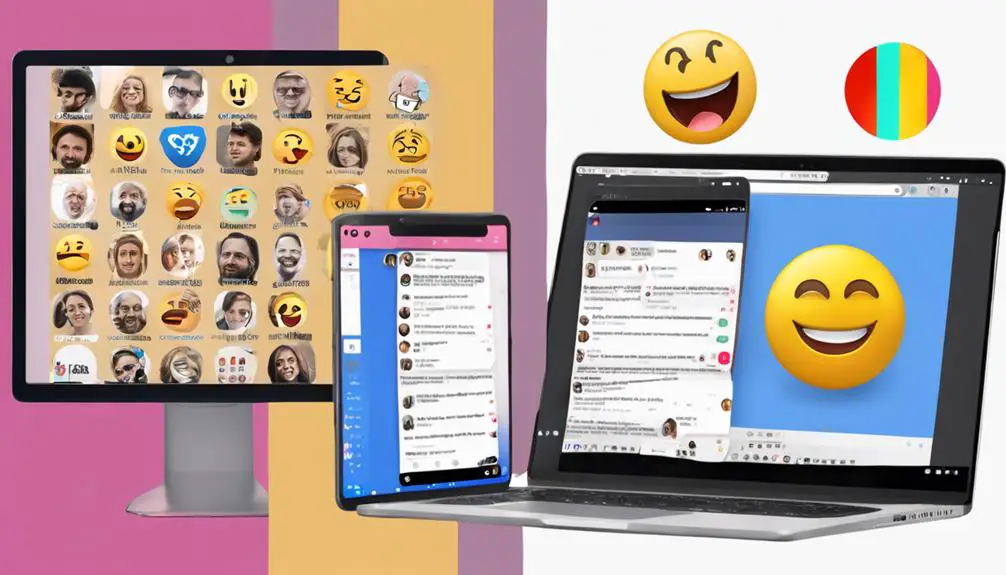When translating English slang to Spanish, you'll face challenges like idiomatic expressions, regional variations, and cultural nuances that lack direct equivalents. You'll need to take into account regional slang in the US, shaped by unique cultural contexts, and its variations in Latin American dialects. Knowing common slang words like 'What's good?' and 'Homie' is essential for effective communication. Understanding formal vs informal language and cultural nuances in slang is important to avoid misunderstandings. As you navigate the complexities of slang translation, you'll discover more about the cultural contexts and linguistic barriers that shape language appropriateness.
Slang Translation Challenges

When translating slang from English to Spanish, you often encounter idiomatic expressions, colloquialisms, and cultural references that frequently lack direct equivalents in the target language. This absence of direct equivalence creates significant linguistic barriers that can impede accurate translation.
For example, English slang often relies on wordplay, irony, and cultural allusions that may not exist or resonate with Spanish speakers. Additionally, colloquialisms and idioms can be region-specific, making it difficult to find suitable equivalents in Spanish.
Technological limitations also present a significant challenge in slang translation. While machine translation tools can offer instant translations, they often struggle to capture the nuances and context of slang terms. This can result in inaccurate or misleading translations that don't effectively convey the intended meaning.
Furthermore, the constant evolution of slang language means that translation tools and resources may not be equipped to handle the latest terms and expressions. As a result, human translators must be mindful of these limitations and work to find creative solutions to overcome the linguistic barriers and technological limitations that arise in slang translation.
English Slang in Different Regions
In the United States, you'll encounter diverse regional slang variations, such as New York City's 'fuhgeddaboudit' or the Southern 'y'all,' which reflect local culture and history. These regional dialects are shaped by the unique cultural, social, and economic contexts of each area.
For instance, urban dialects, such as African American Vernacular English (AAVE) and Chicano English, have developed in cities with high concentrations of ethnic minorities. These dialects often blend elements of standard English with words and phrases from other languages, creating a distinct linguistic identity.
Regional identity is closely tied to the slang used in each area. In the Northeast, you might hear 'wicked' used as an adverb to emphasize a point, while in the Midwest, 'you guys' is a common way to address a group of people.
Understanding these regional variations is essential for accurate translation and cultural sensitivity. By recognizing the cultural significance of regional slang, you can better navigate the nuances of language and avoid misunderstandings.
As you explore the world of slang, remember that language is deeply rooted in local culture and history.
Common Slang Words to Know

Understanding slang is crucial in everyday conversations, and grasping their meanings is vital for effective communication. As you navigate the world of slang, you'll discover that many expressions have their origins in urban culture and African American Vernacular English (AAVE). Slang roots can be traced back to the early 20th century, when African Americans utilized coded language to communicate secretly.
Here are some common slang words to know:
| English Slang | Spanish Translation |
|---|---|
| What's good? | ¿Cómo estás? |
| Homie | Amigo |
| Lowkey | Secretamente |
| Fam | Familia |
These urban expressions are crucial for understanding modern conversations. Mastering slang will help you connect with native speakers and avoid misunderstandings. Remember, slang is constantly evolving, so staying up-to-date with the latest expressions is crucial. By familiarizing yourself with common slang words, you'll be better equipped to communicate effectively in everyday conversations.
Formal Vs Informal Language
Mastering the distinction between formal and informal language is vital for effective communication, as it allows you to adapt your tone and vocabulary to suit different social contexts and audiences.
When communicating in Spanish, it's important to recognize the language hierarchy and adjust your tone accordingly. Formal language is typically used in professional, academic, or official settings, conveying a polite tone and respect for the audience. You'll often use formal language when addressing people you don't know well, such as in business emails or formal presentations.
On the other hand, informal language is used with friends, family, or in casual social settings, and is often characterized by colloquial expressions and slang. Understanding the difference between formal and informal language will enable you to communicate effectively and avoid misunderstandings.
Cultural Nuances in Slang

As you venture into the world of Spanish slang, cultural nuances play a significant role in determining the appropriateness and effectiveness of your language. You'll soon realize that what's acceptable in one region or community may not be in another. This highlights the importance of understanding the cultural context in which slang is used.
Slang evolution is closely tied to language identity, and it's vital to recognize how cultural nuances shape the way people express themselves.
For instance, in some Latin American countries, certain slang terms are closely associated with specific social classes or age groups. Using the wrong term can lead to misunderstandings or even offense. Additionally, language identity is deeply rooted in cultural heritage, and slang is often a reflection of this heritage.
As you navigate the complex world of Spanish slang, it's crucial to be aware of these cultural nuances to avoid miscommunication. By doing so, you'll be able to effectively communicate with native speakers and demonstrate a deeper understanding of their culture.
Idioms and Expressions Translation
When translating idioms and expressions from English to Spanish, capturing the cultural and linguistic nuances that underlie these figurative language forms is vital to achieve accurate and natural-sounding translations.
As you explore the world of idioms and expressions, you'll find that understanding their origins and evolution is key to conveying the intended meaning. You see, idioms often have unique cultural connotations that don't directly translate, making it necessary to grasp their underlying context.
For instance, the idiom 'break a leg' means 'good luck,' but its origin dates back to the superstition that it's bad luck to wish someone 'good luck' directly.
When translating idioms, it's important to take into account the expression's evolution and cultural significance. You must ask yourself, 'What is the equivalent expression in Spanish that conveys the same cultural nuance?' This requires a deep understanding of both languages and cultures. By doing so, you'll be able to create translations that not only convey the literal meaning but also capture the intended tone and cultural essence.
Slang in Different Industries

To guarantee accuracy, it's crucial for translators to familiarize themselves with the specific terminology and nuances of various industries such as healthcare, finance, and technology.
As a translator, you'll need to grasp industry jargon to effectively convey the intended meaning. For instance, in healthcare, you might come across terms like 'stat' (short for 'statim,' meaning immediately) or 'code brown' (a hospital code for a patient who's soiled themselves).
In finance, you might hear 'bull' (a person who buys securities in anticipation of a price increase) or 'bear' (a person who sells securities in anticipation of a price decrease).
In technology, you'll encounter tech lingo like 'bug' (an error or flaw in a program) or 'hack' (a clever solution to a problem).
Being aware of these terms is crucial for providing accurate translations that resonate with the target audience. By doing so, you'll ensure that your translations aren't only linguistically accurate but also culturally relevant and effective.
Regional Spanish Slang Variations
You'll encounter distinct regional variations in Spanish slang, which you must consider to guarantee accurate translations that resonate with local audiences.
Latin American dialects, for instance, have unique slang expressions that differ greatly from those used in Spain. Argentine colloquialisms, such as 'boludo' (dude) and 'che' (a casual way to address someone), are distinct from Mexican street talk, where ' Güey' (dude) and 'Chido' (cool) are commonly used. Meanwhile, Caribbean slang phrases, like 'pana' (buddy) in the Dominican Republic, have their own flavor.
When translating slang, it's important to recognize and incorporate these regional nuances to avoid cultural missteps.
Spanish regional accents, such as the Andean or Rioplatense accents, also influence the slang used in different areas. For example, in Peru, 'chibolo' means 'cool,' while in Argentina, it means 'kid.' Understanding these variations is vital to creating translations that resonate with local audiences and avoid cultural misunderstandings.
Slang in Social Media Context

As you navigate social media, you've likely encountered a plethora of slang terms and abbreviations that can be confusing, especially for non-native speakers. Social media platforms have become a breeding ground for slang, where users freely create and disseminate informal language, often leaving translators scrambling to keep up with the latest expressions and abbreviations.
| Slang Term | Meaning |
|---|---|
| FOMO | Fear of Missing Out |
| Yaaas/Yikes | Expressing strong approval/disapproval |
| Lowkey/Highkey | Expressing subtle or intense feelings |
| Salty/Savage | Being bitter or ruthless |
Influencers and online personalities often create their own lingo, which can spread rapidly across social media platforms. Online dialects emerge as a result, making it challenging for translators to keep up with the ever-changing landscape of slang. As a translator, it's essential to stay informed about the latest slang trends to ensure accurate translations that resonate with your target audience.
Mastering Slang for Better Communication
Mastering slang is vital in today's digital age, where effective communication hinges on being conversant in the latest colloquialisms that permeate online interactions.
As you navigate the vast expanse of social media, you'll encounter slang terms that can either bridge or widen the gap between you and your audience. To avoid misunderstandings and language barriers, it's essential to stay updated on the ever-evolving slang landscape.
Slang evolution is a continuous process, with new terms emerging and old ones fading away. You must be able to keep pace with these changes to guarantee seamless communication.
For instance, using outdated slang can make you appear out of touch, while using current slang can make you seem relatable and in-the-know. By mastering slang, you can transcend language barriers and connect with your audience on a deeper level.
This is especially important when communicating with diverse groups, where cultural nuances can greatly impact the success of your message. By staying slang-savvy, you can break down language barriers and foster more effective communication.
Frequently Asked Questions
How Do I Know if a Slang Term Is Offensive or Inappropriate?
When you encounter a slang term, it's important to take into account cultural nuances and historical context to determine if it's offensive or inappropriate.
You should research the term's origins, evolution, and current usage to understand its connotations.
Be mindful of power dynamics, marginalized groups, and potential triggers.
Don't assume a term is harmless; instead, take the time to educate yourself on the complexities surrounding it.
Are There Slang Translation Apps I Can Use for Instant Help?
You're exploring unfamiliar linguistic waters, and a trusty map is essential. Luckily, you have access to a treasure trove of slang translation apps that can be your travel essentials.
Apps like iTranslate, TripLingo, and Slang Dictionaries can provide instant help, ensuring you don't get lost in translation.
With these tools, you'll be equipped to communicate effectively, avoiding unintended offense or confusion.
Can I Use Machine Translation for Slang Phrases?
When considering machine translation for slang phrases, you'll face challenges. Machine translation often struggles to capture slang nuances, relying on literal translations that miss the mark.
Cultural context is important in slang translation, and machines may not fully grasp the subtleties. While they can provide a starting point, it's important to review and edit translations to guarantee accuracy and cultural sensitivity.
How Do I Keep up With Rapidly Changing Slang Terminology?
You're wondering how to keep up with rapidly changing slang terminology. To stay current, you'll need to be proactive.
Regularly consult slang dictionaries to stay informed about new phrases and their meanings.
Additionally, immerse yourself in the culture by engaging with social media, watching TV shows and movies, and interacting with people from different backgrounds.
This cultural immersion will help you pick up on slang terms as they emerge.
Are There Universal Slang Terms That Transcend Regional Differences?
You think you're a slang master, don't you? Newsflash: regional differences are real. But, surprisingly, some slang terms defy geographical boundaries.
Conducting a cross-cultural analysis reveals global slang patterns. You'll find that certain terms, like 'lowkey' or 'savage,' are universally understood. It's not a coincidence; social media has created a global slang melting pot.
Conclusion
You've mastered the art of slang translation from English to Spanish, but you might be thinking, 'Will I ever be able to keep up with the constantly evolving slang landscape?'
Rest assured, with a deep understanding of regional nuances, cultural context, and industry-specific terminology, you'll be well-equipped to navigate the complex world of slang.
By staying informed and flexible, you'll overcome the challenge of slang translation and become a master communicator.







